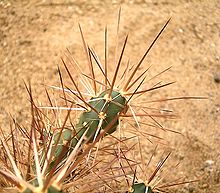Maihueniopsis
| Maihueniopsis | ||||||||||||
|---|---|---|---|---|---|---|---|---|---|---|---|---|

Maihueniopsis subterranea |
||||||||||||
| Systematics | ||||||||||||
|
||||||||||||
| Scientific name | ||||||||||||
| Maihueniopsis | ||||||||||||
| Speg. |
Maihueniopsis is a genus of plants inthe cactus family (Cactaceae). Its botanical name indicates its similarity to the but unrelated genus Maihuenia .
description
Maihueniopsen are low stem and root succulents . Sometimes they branch slightly, but mostly strongly and form loose to dense cushions that can reach 1 to 2 m in diameter. The beet roots of the plants are usually more voluminous than the above-ground parts of slightly branching and small-limbed species. The limb-shaped branches are mostly oval, sometimes variable and mostly gray-green, sometimes brown in color. The areoles are not or only slightly raised on them , often sunk in small dents. They are only slightly present at the base and are more concentrated up to the tips of the mostly conical limbs. The spines are only slight or non-existent at the base and stronger at the ends of the links. The areoles often have long clusters of glochids as well as a few, often flattened thorns , which are mainly formed afterwards on already fully grown limbs. The leaves are small, awl-shaped and quickly decay.
The flowers, which arise individually from the areoles, are usually significantly larger than the limbs. They correspond to the structure which is quite uniform in the subfamily Opuntioideae . The flower colors range from yellow to orange and pink to purple. The seeds formed by the green or yellow fruits are flattened in the shape of a lens.
distribution
The distribution area of the Maihueniopsen is in Argentina , Bolivia and Chile . Since the plants prefer rough and cool locations, they occur in the Andes far above the tree line up to altitudes of 4000 m above sea level. In the comparatively rough south of Patagonia , they also grow near the sea coast.
Systematics
Since Maihueniopsis is difficult to distinguish from other genera due to its morphological features, almost all of the species currently included in it belonged to Austrocylindropuntia , Cumulopuntia , Opuntia , Tephrocactus or the synonymous genera Pseudotephrocactus Frič and Puna R. Kiesling . Most of them have already been recombined several times. Likewise, some species that used to belong to Maihueniopsis now belong to Austrocylindropuntia , Cumulopuntia , Miqueliopuntia and Tephrocactus . A final clarification about the status of the genus Maihueniopsis and the species belonging to it will probably only be achieved through DNA analysis .
The type species Maihueniopsis molfinoi originally established by Spegazzini is no longer comprehensible. Their typical property, namely the basal fused limbs, was probably based on a mutation of a single specimen.
According to Edward Frederick Anderson (2005), the genus consists of the following species:
- Maihueniopsis archiconoidea F. Knight
- Maihueniopsis atacamensis (Phil.) F.Ritter
- Maihueniopsis bonnieae (DJFerguson & R.Kiesling) EFAnderson
- Maihueniopsis camachoi (Espinosa) F.Ritter
- Maihueniopsis clavarioides (Otto ex Pfeiff.) EFAnderson
- Maihueniopsis colorea (F.Ritter) F.Ritter
- Maihueniopsis crassispina F. Knight
- Maihueniopsis darwinii (Hensl.) F.Ritter
- Maihueniopsis domeykoensis F. Knight
- Maihueniopsis glomerata (Haw.) R. Kiesling
- Maihueniopsis grandiflora F. Knight
- Maihueniopsis minuta (Backeb.) R. Kiesling
- Maihueniopsis ovata (Pfeiff.) F.Ritter
- Maihueniopsis nigrispina (K.Schum.) R.Kiesling
- Maihueniopsis subterranea (REFr.) EFAnderson
- Maihueniopsis tarapacana (Phil.) F.Ritter
- Maihueniopsis wagenknechtii F.Ritter
Many of the species are quite variable and can vary in size, growth form and thorns at different locations. In Chile there are also natural hybrids between the species represented there.
literature
- Carlo Luigi Spegazzini: Maihueniopsis , Anales Soc.Ci.Argentinia, 99:86, 1925
- Klaus Gilmer & Hans-Peter Thomas: On the culture of Maihueniopsis nigrispina (K.Schumann) Kiesling , KuaS 48 (3): 57-58, 1997
- Klaus Gilmer & Hans-Peter Thomas: Observations on Maihueniopsis glomerata (Haworth) Kiesling , KuaS 48 (9): 193-197, 1997
- Klaus Gilmer & Hans-Peter Thomas: From Northern Argentina: Maihueniopsis mandragora Spegazzini , KuaS 49 (1): 21-22, 1998
- Klaus Gilmer & Hans-Peter Thomas: Well camouflaged in the ground: Observations on Maihueniopsis minuta , KuaS 49 (9): 213-215, 1998
- Klaus Gilmer & Hans-Peter Thomas: Well camouflaged: Puna clavarioides (Pfeiffer) Kiesling at the site , KuaS 51 (11), 2000
- Klaus Gilmer & Hans-Peter Thomas: A little-known South American species: Puna bonnieae (Opuntioideae) , KuaS 55 (1): 1-4, 2004
- Edward F. Anderson: The Cactus Family . Timber Press: Portland (Oregon), 2001, pp. 399 ff. ISBN 0-88192-498-9
Individual evidence
- ^ Edward F. Anderson : The great cactus lexicon . Eugen Ulmer KG, Stuttgart 2005, ISBN 3-8001-4573-1 , p. 361-366 .




